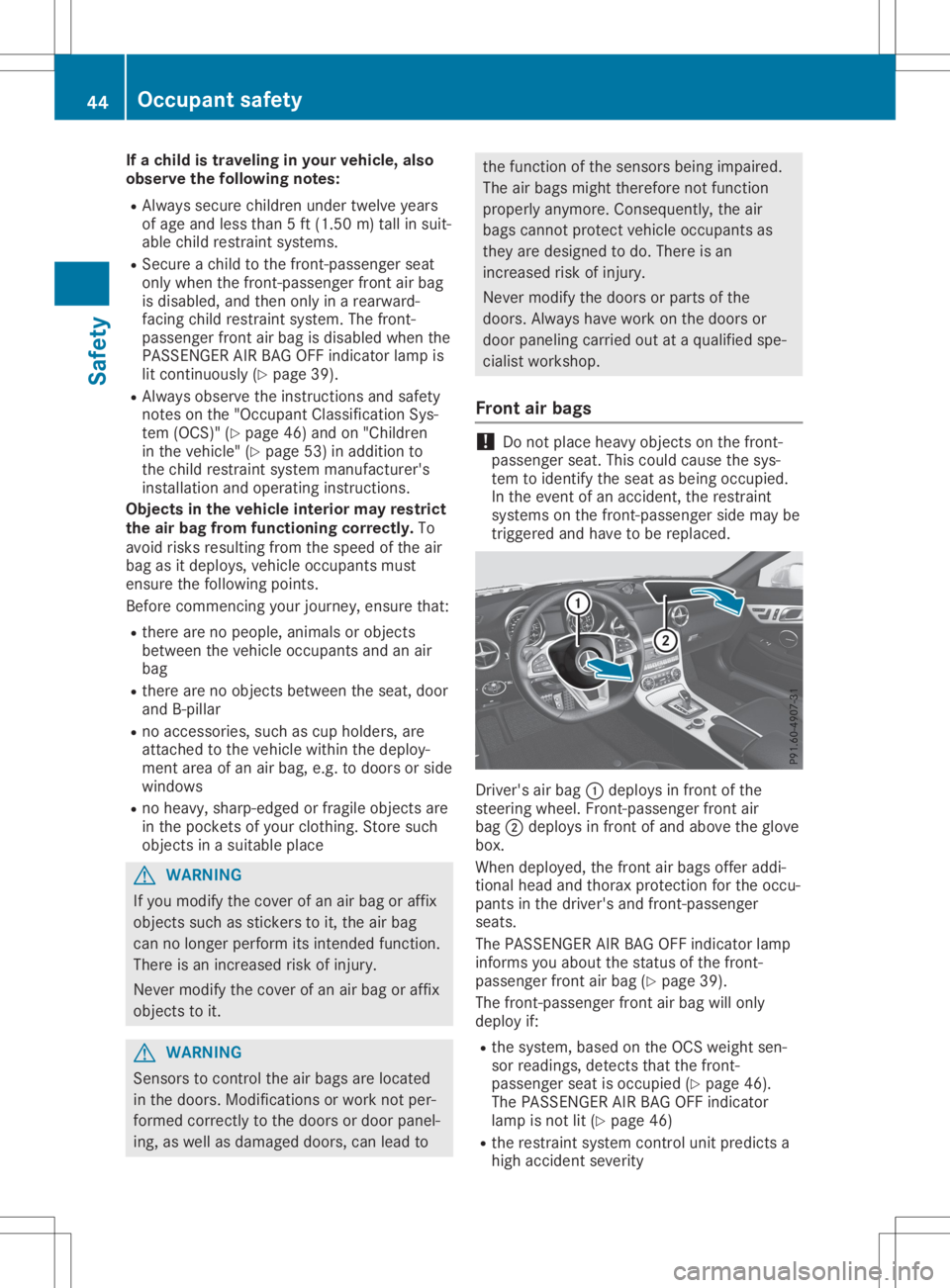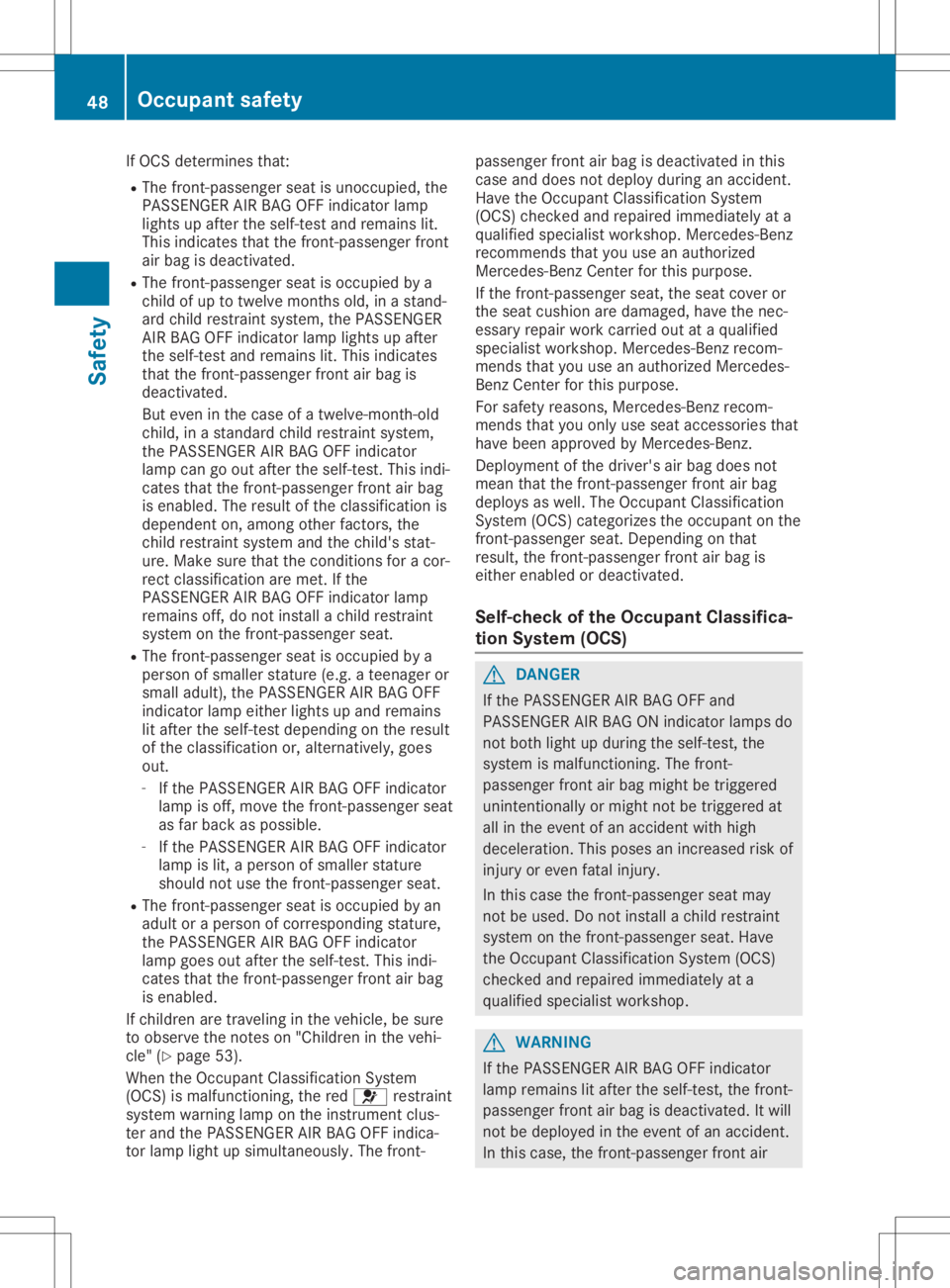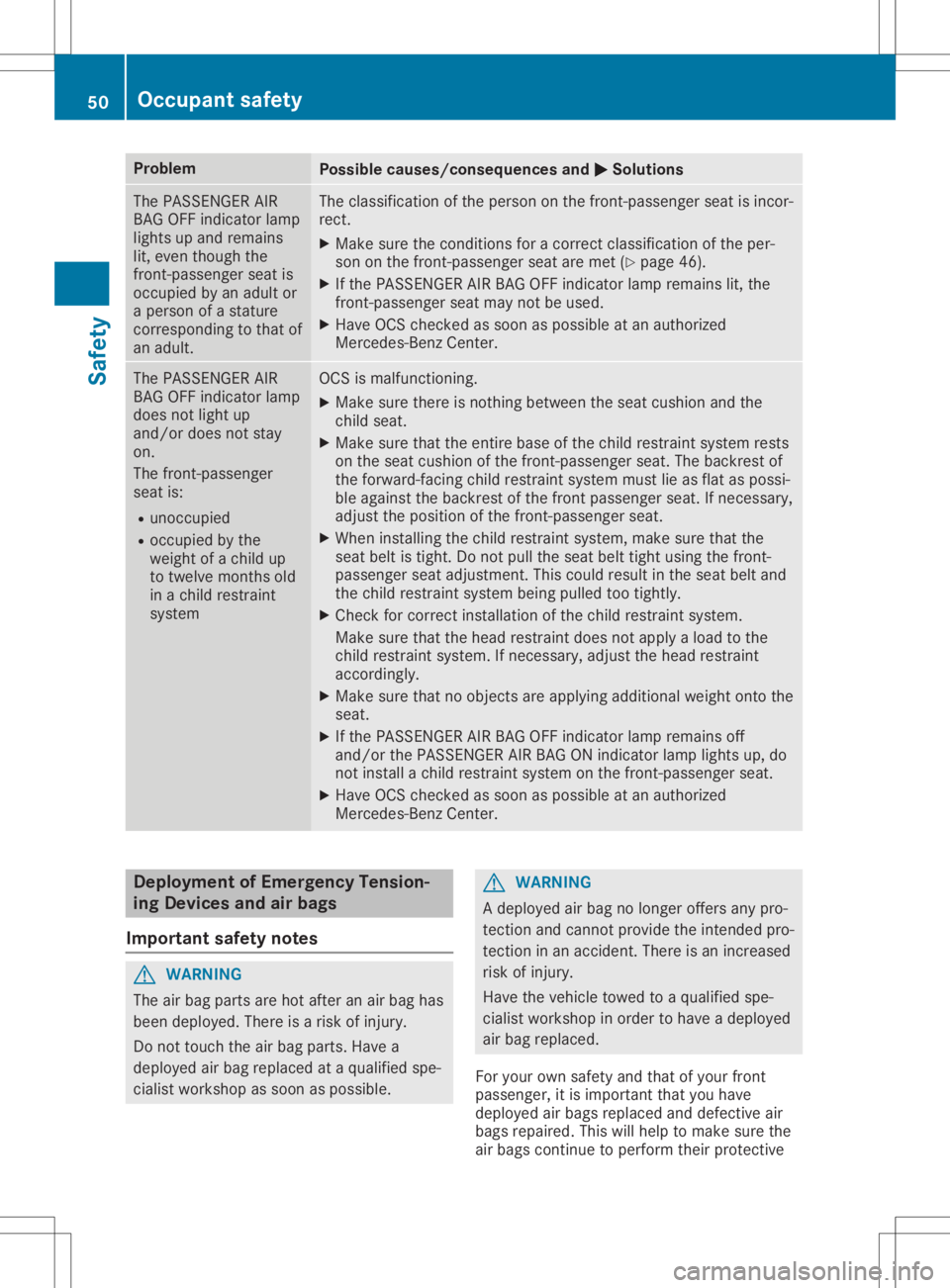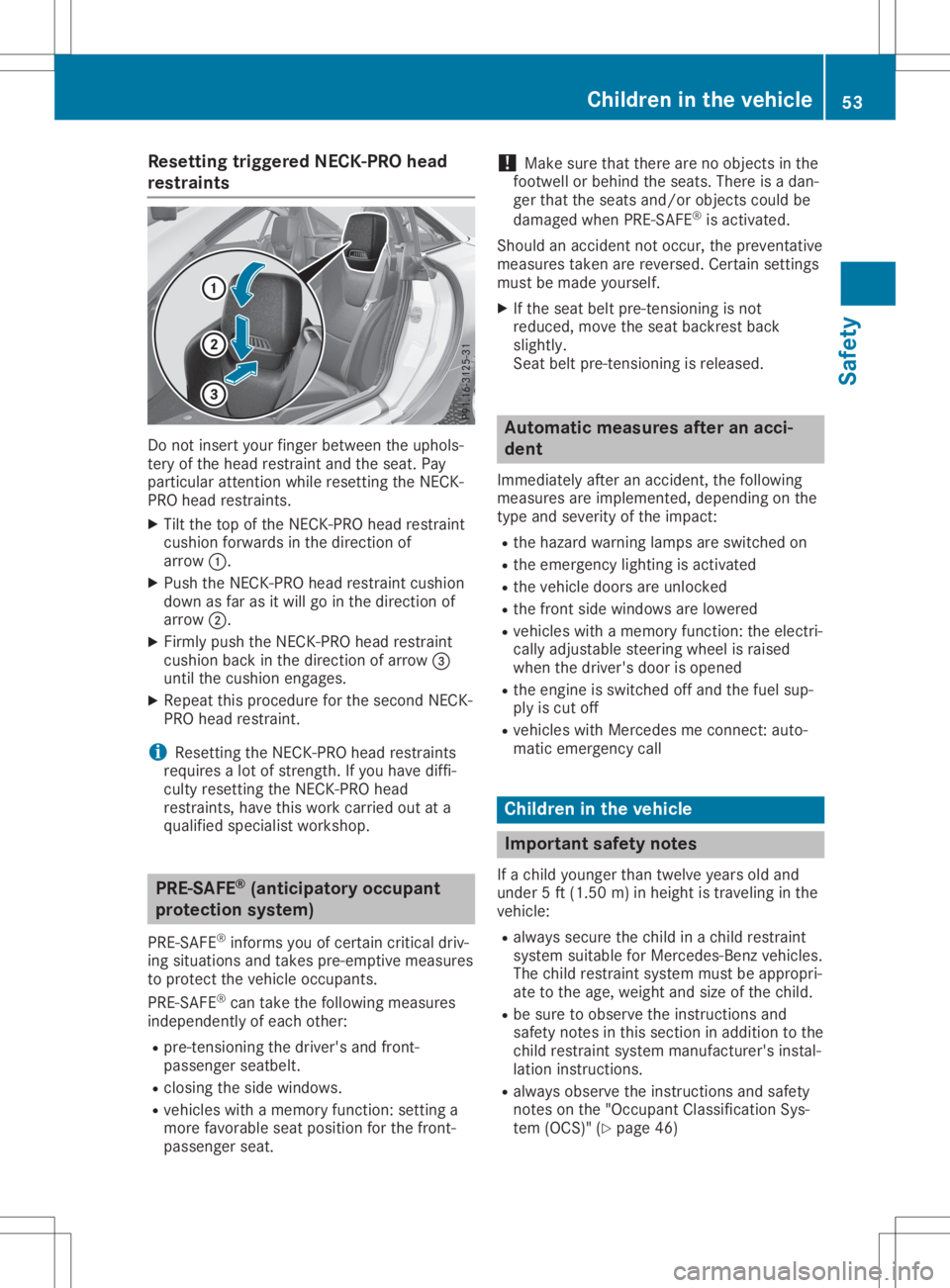2020 MERCEDES-BENZ SLC child seat
[x] Cancel search: child seatPage 45 of 310

If
the vehicle 'sspeed exceeds 15mph
(25 km/h) onceandthedriver's andfront-
passe ngerseatbelts arenot fastened, awarn-
ing tone sounds. Awarning tonealsosounds
with increasing intensityfor60seconds or
until thedriver orfront passe ngerhave fas-
tened theirseatbelts.
If the driver orfront passe ngerunfasten their
seat belts duringthe journey, theseat belt
warning isactivated again. Air
bags
Introductio n The
installa tionpoint ofan airb agcan berec-
ognized bythe AIRBAG marking.
An airb agcomplements thecorrectly fastened
seat belt. Itis no substitu tefor the seat belt.
When deployed ,ana irbag can increase the
protection providedfor the respective vehicle
occupant.
Not allairb ags aredepl oyed inan accident.
The variou sairbags work indepe ndently of
each other (Ypage 50).
However, nosystem availabletoday cancom-
pletel yelimi nate injuries andfatali ties.
It is also notpossib leto rule outarisk ofinjury
cause dbyana irbag due tothe high speed at
which theairbagmust bedepl oyed .
Important safetynotes G
WARNING
If the front passe ngerairbag hasbeen acti-
vated, achild onthe front passe ngerseat
may behit bythe front passe ngerairbag in
the event ofan accident. Thereisar isk of
injury orfatal injury.
NEVER usearearwa rd-facing childrestraint
system onaseat protected byan ACTIVE
FRONT AIRBAG; DEATHorSERIOUS INJURY
to the CHILD canoccur.
When installi ngachild restraint systemonthe
front passe ngerseatobserve thevehicle -spe-
cific notes (Ypage 56).Youmust observe
the notes onrearwa rdand forward -facingchild
restraint systemsonthe front-passenger seat. G
WARNING
If you devia tefrom thecorrect seatpositio n,
the airbag cannot perform itsintended pro-
tective function anddeployment mayeven
cause further injuries. Thisposes an
increased riskofinjury oreven fatalinjury.
To avoid anyrisks, eachvehicle occupant
must always make sureofthe follow ing:
R Fasten theseat beltcorrectly. Inthe case
of pregnant womeninparticul ar,make
sure thatthelapbelt isnever routed
across thestomach orabdo men.
R Adopt thecorrect seatpositio nand keep
as far awa yasp ossib lefrom theairbags.
R Observe thefollow ingnotes.
Alway smake sure thatthere arenoobjects
betwee nthe air bag and vehicle occupant.
All vehicle occupants mustobserve thefollow -
ing notes toavoid risksposed bythe airbag
when itdepl oys.
R Adjust theseats properl ybefore beginning
you rjourney. Alwaysmake sure thatthe
seat isin an almos tupright positio n.The
center ofthe head restraint mustsupport
the head atabou teye level .
R Move thedriver's andfront-passenger seats
as far back aspossib le.The driver's seat
positio nmustallow the vehicle tobe driven
safel y.
R Only holdthesteering wheelonthe outsid e.
This allows theairbag tobe fullydepl oyed .
R Alway slea na gainst thebackrest whiledriv-
ing. Donot leanforward orlea na gainst the
door orside window .You may otherwise be
in the depl oyment areaofthe airbags.
R Alway skeep yourfeet inthe footwell in
front ofthe seat. Donot putyourfeet onthe
dashb oard,forexample .Your feet may oth-
erwis ebeint he depl oyment areaofthe air
bag.
R For this reason, always secure persons less
than 5ft(1.50 m)tall insuita blerestraint
systems. Uptothis heigh t,the seat belt
cannot beworn correctly. Occ
upant safety
43Safety Z
Page 46 of 310

If
ac hild istravel inginyou rvehi cle, also
obser vethef ollowi ngnot es:
R Always secure childre nunde rtwe lve years
of age and less than 5ft(1.5 0m )tallins uit-
ab lechi ldres traint syste ms.
R Secu reac hild to the front-pa ssenge rseat
onl yw hent he front-pa ssenge rfront airb ag
is disa bled ,and the nonlyi nar earw ard-
fa cing childres traint syste m. The front-
pa sse nge rfront airb ag isdisa bled when the
PASSEN GERAIRBAG OFFindicator lamp is
li tc onti nuously(Y page 39).
R Alw ayso bserve the instructio nsand safety
note sonthe "Occu pant Clas sific ati on Sys -
tem (OCS) "(Y pa ge 46) and on"Child ren
in the vehicle" (Y page 53)ina dditio nt o
the childres traint syste mm anufactu rer's
ins tallatio na nd opera ting instructio ns.
Ob jec tsinthe vehic leinteri ormay restric t
the airbag fromf uncti oningc orrec tly.To
av oidr isks res ulting fromt hespee do fthe air
ba ga sitd eploys, veh icleo ccu pants must
ens uret he followi ng points .
Befo recomm encingyour jou rney ,ensuret hat:
R the rearen op eople, ani ma lsor objects
be twe enthe vehicleo ccu pants and anair
ba g
R the rearen oo bjects betwe enthe seat, door
and B-pillar
R no acc essor ies, su ch ascup holders, are
atta chedtothe veh iclew ithi nt he deploy -
ment area ofan airb ag,e .g.t od oors or side
wi ndo ws
R no heavy, sha rp-e dged orfra gile ob jects are
in the pockets ofyour clo thing. Store such
ob jects inas uita blep lace G
WA
RNING
If yo um odify the cove rofana irba go raffix
ob jects such assticker stoit,the airb ag
can nolonge rperform itsinte ndedfunctio n.
The reisan incr easedr isko finju ry.
Nev ermod ifythe cove rofana irba go raffix
ob jects toit. G
WA
RNING
Sens orstocontro lthe airb agsa relocate d
in the doors .M odificati ons orwo rknot per-
for med correctlytot he doors ordoor panel -
ing ,asw ella sd am aged doors ,can lead to the
functio nofthe senso rsbeing impaire d.
The airb agsm ight the refore not functio n
pro perly any mor e.Co nse quentl y,the air
ba gs cann otpro tect vehicleo ccu pants as
the yaredesigne dtod o.The reisan
incr easedr isko finju ry.
Nev ermod ifythe doors orparts ofthe
do ors .Alway sh avew orko nthe doors or
do or panel ing carriedo utataq ualifi ed spe-
cia list wo rksh op.
Fro ntair bag s !
Do
not place heavyo bjects onthe front-
pa sse nge rseat.Thi scouldcau sethe sys-
tem toidenti fythe seat as being occu pied .
In the eventofan acc ident, therestraint
sy ste ms onthe front-pa ssenge rsidem aybe
trig gered and have tobe rep laced . Dri
ver 'sairb ag 0043 deploy sinf ront ofthe
ste ering wheel.Fron t-passenge rfront air
ba g0044 deploy sinf ront ofand above theglove
bo x.
Wh endeploy ed ,the frontairb agso ffer addi-
tio nal head and thoraxpro tecti onfor the occu -
pa nts inthe driver 'sand front-pa ssenge r
se ats .
The PASSEN GERAIRBAG OFFindicator lamp
inf orm syou abou tthe status ofthe front-
pa sse nge rfront airb ag (Y pa ge 39).
The front-pa ssenge rfront airb ag willonl y
de ploy if:
R the syste m, basedo nthe OC Sw eigh ts en-
sor readings ,detects thatthe front-
pa sse nge rseatiso ccu pied (Ypage 46) .
The PASSEN GERAIRBAG OFFindicator
la mp isnot lit( Ypa ge46)
R the restraint syste mc ontro lunitp redicts a
hi gh acc ident sever ity 44
Oc
cupant safetySafe ty
Page 48 of 310

seat
belt, ahead bagmay bedeploy edinother
accident situations (Ypage 50).
The head bagonthe front -passenger side
deploy sunder thefollowi ngconditions:
R the OCS system detects thatthefront -
passenger seatisoccupied or
R the seat beltbuckle tongue isengaged in
the belt buckle ofthe front -passenger seat
If the belt tongue isengaged inthe belt
buckle, thehead bagonthe front -passenger
side deploy sifa na ppropria teaccident situa-
tion occurs. Inthis case, deploy mentisinde-
pendent ofwhether thefront -passenger seatis
occupied ornot. Occupant
ClassificationSystem
(OCS)
Introduction The
Occupant Classification System(OCS)cat-
egorizes theperson inthe front -passenger
seat. Depending onthat result, thefront -
passenger frontairbag and front -passenger
knee bagareeither enabled ordeactivated.
The system doesnotdeactivate:
R the side impact airbag
R the headba g
R the Emergenc yTensioning Devices
Requirements To
be classified correctly,the front passenger
must sit:
R with theseat beltfastened correctly
R in an almost upright position withtheir back
agai nstthe seat backrest
R with their feetresting onthe floor, ifpossi-
ble
If the front passenger doesnotobserve these
conditions, OCSmayproduce afalse classifi-
cation, e.g.because thefront passenger:
R transfers theirweight bysupporting them-
selves onavehicle armrest
R sits insuch awaythat their weight israised
from theseat cushion
If you install achild restraint systemonthe
front -passenger seat,besure toobserve the
correct positioning ofthe child restraint sys-
tem. Never placeobjects underorbehind the child
restraint system,e.g.acushion. The
entire baseofthe child restraint systemmust
alwa ysrest onthe seat cushion ofthe front -
passenger seat.Thebackrest ofthe forward-
facing childrestraint systemmustlieasflat as
possible againstthe backrest ofthe front -
passenger seat.
The child restraint systemmustnottouch the
roof orbe subjected toaload bythe head
restraint. Adjusttheangle ofthe seat backrest
and thehead restraint positionaccordingly.
Only thencanOCS beguara nteed tofunction
correct ly.Always observe thechild restraint
system manufacturer's installationandoperat-
ing instruct ions.
Occupant ClassificationSystem opera-
tion (OCS) 0043
PASSE NGERAIRBAG ONindicator lamp
0044 PASSE NGERAIRBAG OFFindicator lamp
The indicator lampsinform youwhether the
front -passenger frontairbag isdeactivated or
enabled.
X Press theStart/ Stopbutton onceortwice,
or turn theSmartKey toposition 0047or0048 in
the ignition lock.
The system carriesout<00560048004F004900100047004C0044004A0051005200560057004C00460056
0011[
The PASSE NGERAIRBAG OFFand
PASSE NGERAIRBAG ONindicator lampsmust
light upsimultaneousl yfor approximately six
seconds.
Then theindicator lampsdisplaythe status of
the front -passenger frontairbag:
R PASSE NGERAIRBAG ONlights upfor
60 seconds, subsequentlybothindicator
lamps areoff(PASSE NGERAIRBAG ONand 46
Occ
upant safetySafety
Page 49 of 310

OFF):
thefront -passenger frontairbag is
able todeploy inthe event ofan accident.
R PASSE NGERAIRBAG OFFlights up:the
front passenger frontairbag isdeactivated.
It will then notbedeploy edinthe event of
an accident.
If the PASSE NGERAIRBAG ONindicator lamp
is off, only thePASSE NGERAIRBAG OFFindi-
cator lampshows thestatus ofthe front -
passenger frontairbag. ThePASSE NGERAIR
BAG OFFindicator lampmaybelitcont inu-
ously orbe off.
If the status ofthe front -passenger frontair
bag changes whilethevehicle isin motion, an
air bag displa ymessage appearsinthe instru-
ment cluster (Ypage 192). When thefront -
passenger seatisoccupied, alwayspay atten-
tion tothe PASSE NGERAIRBAG OFFindicator
lamp. Beawa reofthe status ofthe front -
passenger frontairbag both before andduring
the journey. G
WARNING
If the PASSE NGERAIRBAG OFFindicator
lamp islit, the front -passenger frontairbag
is disabl ed.Itwill notbedeploy edinthe
event ofan accident andcannot perform its
intended protective function.Aperson inthe
front -passenger seatcould then,forexam-
ple, come intocontactwith thevehicle's
interior, especiallyifthe person issitting too
close tothe dashboa rd.This poses an
increased riskofinjury oreven fatalinjury.
When thefront -passenger seatisoccupied,
alwa ysensure that:
R the classification ofthe person inthe
front -passenger seatiscorrect andthe
front -passenger frontairbag isenabled or
disabl edinaccordance withtheperson in
the front -passenger seat
R the front -passenger seathasbeen moved
back asfar back aspossible .
R the person isseated correctly.
Make sure,bothbefore andduring thejour-
ney, thatthestatus ofthe front -passenger
front airbag iscorrect . G
WARNING
If you secure achild inar earward-facing
child restraint systemonthe front -
passenger seatandthePASSE NGERAIR
BAG OFFindicator lampisoff, thefront -
passenger frontairbag candeploy inthe
event ofan accident. Thechild could be
struck bythe airbag. Thisposes an
increased riskofinjury oreven fatalinjury.
Make surethatthefront -passenger frontair
bag hasbeen deactivated. ThePASSE NGER
AIR BAG OFFindicator lampmust belit.
NEVER usearearward-facing childrestraint
on aseat protected byan ACTIVE FRONT
AIRBAG infront ofit;DEA THorSERIOUS
INJURY tothe child canoccur.
If the PASSE NGERAIRBAG OFFindicator lamp
stays off,donot install arearward-facing child
restraint systemonthe front -passenger seat.
You canfind more information onOCS under
"Proble mswith theOccupant Classification
System" (Ypage 49). G
WARNING
If you secure achild inaf orward-facing child
restraint systemonthe front -passenger seat
and youposition thefront -passenger seat
too close tothe dashboa rd,inthe event of
an accident, thechild could:
R come intocontactwith thevehicle's inte-
rior ifthe PASSE NGERAIRBAG OFFindi-
cator lampislit, for example
R be struck bythe airbag ifthe
PASSE NGERAIRBAG OFFindicator lamp
is off
This poses anincreased riskofinjury or
even fatalinjury.
Move thefront -passenger seatasfar back
as possible .Alway smake sure thatthe
shoulde rbelt strap iscorrect lyrouted from
the vehicle beltguide tothe shoulde rbelt
guide onthe child restraint system.The
shoulde rbelt strap mustberouted forwards
and downwards fromthevehicle beltguide .
Alway sobserve thechild restraint system
manufacturer's installationinstructions. Occ
upant safety
47Safety Z
Page 50 of 310

If
OCS determines that:
R The front-passenger seatisunoccupi ed,the
PASSENGER AIRBAG OFFindicator lamp
lights upafter theself-test andremains lit.
This indicates thatthefront-passenger front
air bag isdeactiva ted.
R The front-passenger seatisoccupie dbya
child ofup totwelve months old,inas tand-
ard child restraint system,thePASSENGER
AIR BAG OFFindicator lamplights upafter
the self-test andremains lit.This indicates
that thefront-passenger frontairbag is
deactiva ted.
But even inthe case ofat welve-month-old
child, inas tandard childrestraint system,
the PASSENGER AIRBAG OFFindicator
lamp cangoout after theself-test. Thisindi-
cates thatthefront-passenger frontairbag
is enabled. Theresul tofthe classi fication is
depende nton, among otherfactors, the
child restraint systemandthechild's stat-
ure. Make surethattheconditions foracor-
rect classi fication aremet. Ifthe
PASSENGER AIRBAG OFFindicator lamp
remains off,donot install achild restraint
system onthe front-passenger seat.
R The front-passenger seatisoccupie dbya
person ofsmall erstature (e.g.ateenager or
small adult),the PASSENGER AIRBAG OFF
indicator lampeither lightsupand remains
lit after theself-test dependingon the resul t
of the classi fication or,alternativel y,goes
out.
- Ifthe PASSENGER AIRBAG OFFindicator
lamp isoff, move thefront-passenger seat
as far back aspossib le.
- Ifthe PASSENGER AIRBAG OFFindicator
lamp islit, aperson ofsmall erstature
shoul dnotuse thefront-passenger seat.
R The front-passenger seatisoccupie dbyan
adu ltor ap erson ofcorresponding stature,
the PASSENGER AIRBAG OFFindicator
lamp goesoutafter theself-test. Thisindi-
cates thatthefront-passenger frontairbag
is enable d.
If childre naretraveling inthe vehicle ,bes ure
to observe thenotes on"Ch ildre nint he vehi-
cle" (Ypage 53).
When theOccupant Classifica tionSystem
(OCS) ismalfu nctioning, thered 0075 restraint
system warning lamponthe instrument clus-
ter and thePASSENGER AIRBAG OFFindica-
tor lamp lightupsimul taneousl y.The front- passe
ngerfront airbag isdeactiva tedinthis
case anddoes notdepl oyduri nganaccident.
Have theOccupant Classifica tionSystem
(OCS) checked andrepai redimmedi atelyata
qua lifiedspecia listworkshop. Mercedes-Benz
recommends thatyouuseanauthori zed
Mercedes-Benz Centerforthis purpo se.
If the front-passenger seat,theseat cover or
the seat cushio naredama ged,have thenec-
essary repairwork carried outataq ualifie d
specia listworkshop. Mercedes-Benz recom-
mends thatyouuseanauthori zedMercedes-
Benz Center forthis purpo se.
For safety reasons, Mercedes-Benz recom-
mends thatyouonly useseat accessorie sthat
have been appro vedbyMercedes-Benz.
Deploy mentofthe driver's airbag does not
mean thatthefront-passenger frontairbag
depl oysaswell .The Occupant Classifica tion
System (OCS)categorizes theoccupant onthe
front-passenger seat.Depending onthat
resul t,the front-passenger frontairbag is
either enabledordeactiva ted.
Self-c heckofthe Occupant Classifica-
tion System (OCS) G
DA
NGER
If the PASSENGER AIRBAG OFFand
PASSENGER AIRBAG ONindicator lampsdo
not both lightupd uring the self-test, the
system ismalfu nctioning. Thefront-
passe ngerfront airbag might betriggered
unintentionally ormight notbetriggered at
all inthe event ofan accident withhigh
decele ration. Thisposes anincreased riskof
injury oreven fatalinjury.
In this case thefront-passenger seatmay
not beused .Don otinstall achild restraint
system onthe front-passenger seat.Have
the Occupant Classifica tionSystem (OCS)
checked andrepai redimmedi atelyata
qua lifiedspecia listworkshop. G
WARNING
If the PASSENGER AIRBAG OFFindicator
lamp remains litafter theself-test, thefront-
passe ngerfront airbag isdeactiva ted.Itwil l
not bedepl oyed inthe event ofan accident.
In this case, thefront-passenger frontair 48
Occ
upant safetySafety
Page 51 of 310

bag
cann otperfor mitsint ended protective
func tion,e.g. when aperson isseated inthe
fron t-passenger seat.
That person could,forexample, comeinto
con tact with thevehicle's interior, especially
if the person issitt ing too close tothe dash-
board. Thisposes anincr eased riskofinjury
or even fatalinjury.
When thefron t-passenger seatisocc upied,
always ensure that:
R the classific ationofthe person inthe
fron t-passenger seatiscorr ectand the
fron t-passenger frontairbag isenabled or
deactiv atedinaccor dance withtheper-
son inthe fron t-passenger seat
R the person isseated properly withacor-
rect lyfasten edseatbelt
R the fron t-passenger seathasbeen moved
as far back aspossible
If the PAS SENGER AIRBAGO FFindicat or
lamp remains litwhen itshould not,the
fron t-passenger seatmust notbeused. Do
not installac hild restraint system onthe
fron t-passenger seat.Have theOcc upant
Classification System(OCS)checkedand
repaired immediately ataq ualified specialist
worksh op. G
WARN
ING
Objec tsbetween theseat surface andthe
child restraint system couldaffect OCS operation
.This could result inthe fron t-
passenger airbag notfunc tioningasinten-
ded during anacciden t.This poses an
incr eased riskofinjury oreven fatalinjury.
Do not place anyobjec tsbetween theseat
surface andthechild restraint system. The
ent irebase ofthe child restraint system
must always restonthe seat cushion ofthe
fron t-passenger seat.Thebackr estofthe
forward- facingchild restraint system must,
as far aspossible, berest ingonthe back-
rest ofthe fron t-passenger seat.Always
comply withthechild restraint system man-
ufactur er'sinstallation instruct ions.
Aft erthe self-t est,thePAS SENGER AIRBAG
OFF orthe PAS SENGER AIRBAGO Nindicat or
lamp displays thestatusofthe fron t-
passenger frontairbag (Ypage 46).Ifthe
fron t-passenger frontairbag isenabled, the
PAS SENGER AIRBAGO Nindicat orlamp lights
up for 60secon dsand then goes out.
If the PAS SENGER AIRBAGO Nindicat orlamp
is off, only thePAS SENGER AIRBAGO FFindi-
cator lampshows thestatusofthe fron t-
passenger frontairbag. ThePASSENGER AIR
BA GO FFindicat orlamp maybelitcon tinu-
ously orbe off.
For more information abouttheOCS, see
"Problems withtheOcc upant Classification
System "(Ypage 49).
Problems withtheOccupant Classification System(OCS) Be
sure toobserve thenoteson "System self-test"(Ypage 48). Occupant
safety
49Safet y Z
Page 52 of 310

Problem
Possible
causes/co nsequences and0050 0050
Solutions The
PASS ENGER AIR
BAG OFFindicator lamp
lights upand remains
lit, even though the
front -passenger seatis
occupied byan adult or
ap erson ofas tature
correspondin gtot hat of
an adult. The
classification ofthe person onthe front -passenger seatisincor-
rect.
X Make surethecondition sfor ac orrect classification ofthe per-
son onthe front -passenger seataremet (Ypage 46).
X Ifthe PASS ENGER AIRBAG OFFindicator lampremains lit,the
front -passenger seatmaynotbeused.
X Have OCScheck edassoon aspossible atan authorized
Mercedes-Ben zCenter. The
PASS ENGER AIR
BAG OFFindicator lamp
does notlight up
and/or doesnotstay
on.
The front -passenger
seat is:
R unoccupied
R occupied bythe
weight ofac hild up
to twelve monthsold
in ac hild restraint
system OCS
ismalfunctionin g.
X Make surethere isnothin gbetween theseat cushion andthe
child seat.
X Make surethattheentire baseofthe child restraint systemrests
on the seat cushion ofthe front -passenger seat.Thebackrest of
the forward-facing childrestraint systemmustlieasflat aspossi-
ble against thebackrest ofthe front passenger seat.Ifnecessary,
adjust theposition ofthe front -passenger seat.
X When installing thechild restraint system,makesurethatthe
seat beltistight. Donot pull theseat belttight using thefront -
passenger seatadjustment .This could result inthe seat beltand
the child restraint systembeingpulled tootightly.
X Check forcorrect installation ofthe child restraint system.
Make surethatthehead restraint doesnotapply aload tothe
child restraint system.Ifnecessary, adjustthehead restraint
accordingly.
X Make surethatnoobject sareapply ingadditional weightontothe
seat.
X Ifthe PASS ENGER AIRBAG OFFindicator lampremains off
and/or thePASS ENGER AIRBAG ONindicator lamplights up,do
not install achild restraint systemonthe front -passenger seat.
X Have OCScheck edassoon aspossible atan authorized
Mercedes-Ben zCenter. Deployment
ofEmergency Tension-
ing Devic esand airbags
Import antsafety notes G
WARNING
The airbag parts arehot after anair bag has
been deploye d.There isar isk ofinjury.
Do not touch theairbag parts. Havea
deploye dairbag replaced ataq uali fied spe-
cialist workshop assoon aspossible. G
WARNING
Ad eploye dairbag nolonger offersanypro-
tect ionand cannot provide theinten dedpro-
tect ioninan accident. Thereisan increased
risk ofinjury.
Have thevehicle towedtoaq uali fied spe-
cialist workshop inorder tohave adeploye d
air bag replaced.
For your ownsafety andthat ofyour front
passenger, itis important thatyouhave
deploye dairbags replaced anddefective air
bags repaired. Thiswillhelp tomake surethe
air bags continue toperform theirprotect ive 50
Occ
upantsafetySafety
Page 55 of 310

Res
ettingtrigg eredN ECK-P RO head
res traints Do
not inse rtyo ur fing erbetw eentheuphol s-
tery ofthe headrestrai ntand theseat.Pa y
pa rticu lara ttenti onwhiler esetting theNECK -
PR Oh eadr estrai nts.
X Tilt the top ofthe NECK -PROh eadr estrai nt
cus hionforw ardsint he directi onof
arr ow 0043.
X Pu sh the NECK -PROh eadr estrai ntcus hion
dow nasfar as itwi llgo inthe directi onof
arr ow 0044.
X Firm lypu sh the NECK -PROh eadr estrai nt
cus hionb acki nt he directi onofarr ow 0087
unti lthe cus hione nga ges.
X Re pea tthis proced ure forthe seco ndNECK -
PR Oh eadr estrai nt.
i Re
setti ngthe NECK -PROh eadr estrai nts
req uires alot ofstreng th.Ifyo uh aved iffi-
cul tyres etting theNECK -PROh ead
res trai nts, have this workcarr iedo utata
qu alifi ed spe cialist wo rksho p. PRE
-SAFE®
(an ticipato ryoccupa nt
prote ction sys tem)
PR E-SAFE ®
info rms youo fcerta incriti caldriv-
ing situ ations and take spre-emp tivemea sures
to pro tect thevehicleo ccu pants.
PR E-SAFE ®
can take thefollowi ng mea sures
ind epe ndentl yofeacho the r:
R pre -tensi oning thedriver' sand front-
pa sse nger seatbel t.
R clo sing thesidew indow s.
R veh icles with am emo ryfuncti on:setti nga
more favora bles eatp osition for the front-
pa sse nger seat. !
Ma
kesure that there arenoobje ctsinthe
foo twe llor beh indthe seats.The reisad an-
ger that theseatsand /or obje ctscou ldbe
da mag edwhen PRE-SAFE ®
is acti vate d.
Shou ldan acci dent notoccu r,the preventa tive
mea sures take narereve rsed.Ce rtai nsetti ngs
mus tbem adey ourself.
X Ifthe seatbeltp re-tensi oning isnot
red uce d,move theseatbackrest back
sli ghtl y.
Sea tbeltp re-tensi oning isrel eased . Auto
matic measuresafter anacc i-
den t
Imme diate lyafte rana ccident, thefollowi ng
mea sures are implemente d,dep endi ngon the
typ eand sev erityof the impact:
R the hazard warning lamps areswitched on
R the eme rgency lighti ngisacti vate d
R the vehicled oors are unlocked
R the front sidew indow sarelowe red
R veh icles with am emo ryfuncti on:the electri -
cal lyad justa bles tee ring wheel israi sed
wh en the driver' sdooriso pened
R the engi neisswi tched offand thefuelsup -
pl yi sc utoff
R veh icles with Mer cedesme connect: auto-
mati ceme rge ncy call Chi
ldre nint he vehic le Impo
rtant safetynotes
If ac hild young erthan twelveyears olda nd
und er5f t(1.50 m)inhe ight istra vel ing inthe
veh icle:
R alwa yssecur ethe childinac hild res traint
sy ste ms uita blef or Me rced es-Benz vehicles .
The childres traint syste mm ustb ea ppropri -
ate tothe age, we ight and size ofthe child.
R be sure to observe the instructio nsand
sa fety note sint hiss ectio nina dditio nt ot he
chi ldres traint syste mm anufactu rer'sins tal-
la tio ninstru ctio ns.
R alwa ysobserve the instructio nsand safety
note sonthe "Occu pant Clas sific ati on Sys -
tem (OCS) "(Ypa ge46) Ch
ildren inthe vehic le
53Safe ty Z